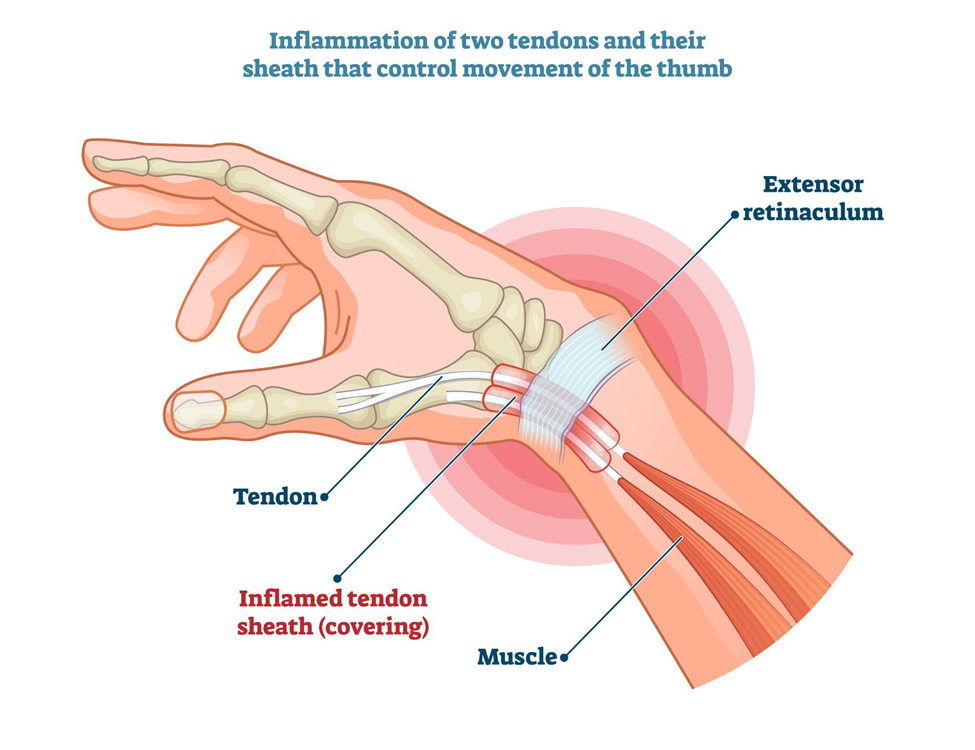
What Is De Quervain’s Tenosynovitis?
De Quervain’s Tenosynovitis was named after the Swiss surgeon who first described the condition in 1895. It is a condition which affects the two tendons that run along the thumb side of the wrist and are responsible for movement of the thumb.
It causes very localised pain, tenderness and sometimes swelling.
Anatomy of De Quervain’s Tenosynovitis

The two thumb tendons; abductor pollicis longus (APL) and extensor pollicis brevis (EPB) are strong rope-like structures that appear at the base of your thumb, on your wrist, when you stick your thumb up. These tendons are surrounded by a ‘tendon sheath’ which provides protection and helps with frictionless movement of the tendons. This sheath is in turn, held in place by a structure called the ‘extensor retinaculum’.This complex mechanism allows the tendons to stay in place but also to move freely and smoothly when using your thumb, such as when typing or using your mobile phone.
What Are The Causes Of DeQuervain’s Tenosynovitis?
Although a clear cause of De Quervain’s Tenosynovitis has not been determined, there is significant evidence pointing to the possibility that this condition is an overuse injury, caused when the APL and EPB tendons are subjected to excessive strain from repetitive movement of the thumb.
It is very common in mums in the first year following childbirth, due to continuous breastfeeding, lifting and caring for a new baby. It is also incredibly common in those who play a lot of computer games, who carry out repetitive manual lifting, do excessive computer and mouse work or play a sport involving gripping.
It is usually linked to a sudden increase in repetitive activity, but can also occur more gradually over time.
When the tendons are subjected to excessive strain, it causes microtrauma and swelling within the tendons. When the swollen tendons rub against the tendon sheath it causes pain at the base of your thumb and wrist. Without appropriate rest, this ongoing trauma leads to further tissue damage, inflammation, swelling and pain. This cycle continues unless it is treated. This is why it is very important to seek professional help from an experienced Physiotherapist if you start feeling any pain in your thumb or wrist.
What CausesOf De Quervain’s Tenosynovitis?
- A direct injury to the thumb tendons
- Gaming
- Manual jobs such as an electrician
- Pregnancy – likely due to hormonal changes
- New mums
- Hobbies like gardening or racket sports
- Inflammatory conditions like rheumatoid arthritis
- Repetitive computer tasks and use of a mouse.
What Are The Symptoms Of De Quervain’s Tenosynovitis?
Patients with de Quervain’s Tenosynovitis often describe a feeling of sharp or dull pain, either at the base of the thumb or at the wrist. People of all ages can develop this condition, however it is much more common in people between the ages of 30-50. Women are far more likely to develop the condition than men.
Symptoms of de Quervain’s Tenosynovitis can include:
- Pain and palpable tenderness along the thumb side of the wrist
- Increased pain when you use the thumb and hand.
- Swelling around the site of pain at the base of the thumb.
- Pain that appears quite suddenly or develops over time.
- Feeling snapping or popping sensation in the wrist when moving the thumb.
How Is De Quervain’s Tenosynovitis Diagnosed?
De Quervain’s can usually be diagnosed by one of our expert Physiotherapists, from your history and clinical examination findings. There is a special clinical test known as Finkelstein’s test (see image below), in which you make a fist with your thumb bent underneath your fingers. You then bend your wrist downwards toward your little finger. If this causes pain on the thumb side of your wrist, you likely have de Quervain tenosynovitis. Your physiotherapist will also palpate (touch) the painful tendons and they are likely to be very tender if you have De Quervain’s tenosynovitis.

Our Physiotherapists at Compete are highly experienced in the diagnosis and treatment of De Quervain’s Tenosynovitis, however, if the diagnosis is in doubt, imaging using either an ultrasound or MRI scan can be helpful.
Diagnostic Ultrasound For De Quervain’s Tenosynovitis
A diagnostic ultrasound scan has been proven to be highly specific at identifying De Quervain’s Tenosynovitis and is more accurate than an MRi scan. Diagnostic ultrasound is used to visualise specific, local inflammation and swelling around the tendons of the thumb. The ultrasound can also assess for any tears in the tendons. The information gained from combining evidence from a clinical examination and diagnostic ultrasound, results in a highly accurate diagnosis, ensuring that you are started on the most appropriate and effective treatment plan.
At Complete Physio we are able to offer a unique ultrasound diagnostic service to our patients, as we have a team of qualified sonographers who can carry out an ultrasound scan, for no extra cost, as part of your clinical assessment.
You will need to be booked in with one of our dual trained Clinical Specialists, so please ensure you inform our administration team at the time of booking.
You can book an appointment with any of our Physiotherapists, either by calling 0207 482 3875 or email us at info@complete-physio.co.uk.
How Do We Treat De Quervain’s Tenosynovitis?
Complete Physio has gained an excellent reputation for providing a highly specialised clinic for patients suffering with tendon pain. We get referrals from many highly regarded sports medicine and orthopaedic consultants, who trust us to ensure their patients are provided with the best possible care.
Due to the necessity of using our hands so frequently for almost all daily activities, De Quervain’s can be quite a difficult condition to treat, and symptoms can easily flare up if not managed correctly.
Your Physiotherapist will discuss with you the most effective treatment options, and will carefully plan and oversee your treatment. They will support you through the whole process from diagnosis to return to full activity or sport.
Physiotherapy
Pain Management
- Ice therapy
- Medication such as NSAIDs or Paracetamol – this should always be prescribed by a pharmacist or doctor
- Acupuncture
Rest and Activity Modification
- Provision of a brace or thumb splint, to hold your thumb in a comfortable, neutral position, and offload the tendons, to allow the inflammation to settle and the tendons to heal.
- Advice on activity modification and how to alter your movements, so that you don’t aggravate and flare up your symptoms.
- Upper limb postural correction including ergonomic changes for your working environment.
Hands On Treatment
- Soft tissue massage
- Joint mobilisations
- Passive stretches
- Acupuncture
Exercise and Rehabilitation
- Thumb, wrist and forearm strengthening exercises
- Thumb, wrist and forearm range of movement exercises
- Functional exercises
- Specific sports or activity related exercises
What If Physiotherapy Treatment Has Not Worked For Your Thumb Pain?
Injection Therapy
If physiotherapy and conservative management has not resolved your symptoms, do not worry, as there is another highly effective treatment option available to you.
Steroid injections under ultrasound guidance offers fast and effective pain relief for De Quervain’s Tenosynovitis. It is a well known, safe treatment option for inflamed tendons within musculoskeletal medicine. An injection is designed to reduce your pain and inflammation, allowing you to effectively rehabilitate your condition.
Complete Physio has a very specialised team of clinicians who have undertaken extensive training to provide this unique service. Our clinical specialists have trained as musculoskeletal sonographers and are also qualified to prescribe medications independently, which means we do not require a referral from your GP for this treatment.
During an ultrasound guided injection a small dose of anti-inflammatory medication (known as a corticosteroid) and a local anaesthetic (short acting numbing agent) is injected into the target tissue.
An ultrasound guided steroid injection for De Quervain’s tenosynovitis is usually incredibly effective and well tolerated, and most patients will experience a significant reduction of symptoms within a week. Following the injection It is vitally important that you resume further physiotherapy to ensure that your symptoms do not return.
Surgery for De Quervain’s Tenosynovitis?
Surgery is usually reserved for serious cases that have not resolved with conservative management or injection therapy. From our experience it is uncommon that a steroid injection and physiotherapy does not resolve your symptoms. The surgery is carried out as a day case and involves the surgeon inspecting the sheath surrounding the thumb tendons, and then opening the sheath to release the pressure. This allows the tendons to glide freely. You will require intensive hand physiotherapy postoperatively
If you have been diagnosed with De Quervain’s Tenosynovitis or you think you might be suffering from this condition then please contact us to book an appointment on info@complete-physio.co.uk or call us on 02074823875. If you would like to speak to one of our highly experienced clinicians about your condition and treatment options, then this can also be arranged through our booking team.
Don’t let pain hold you back, book now!




